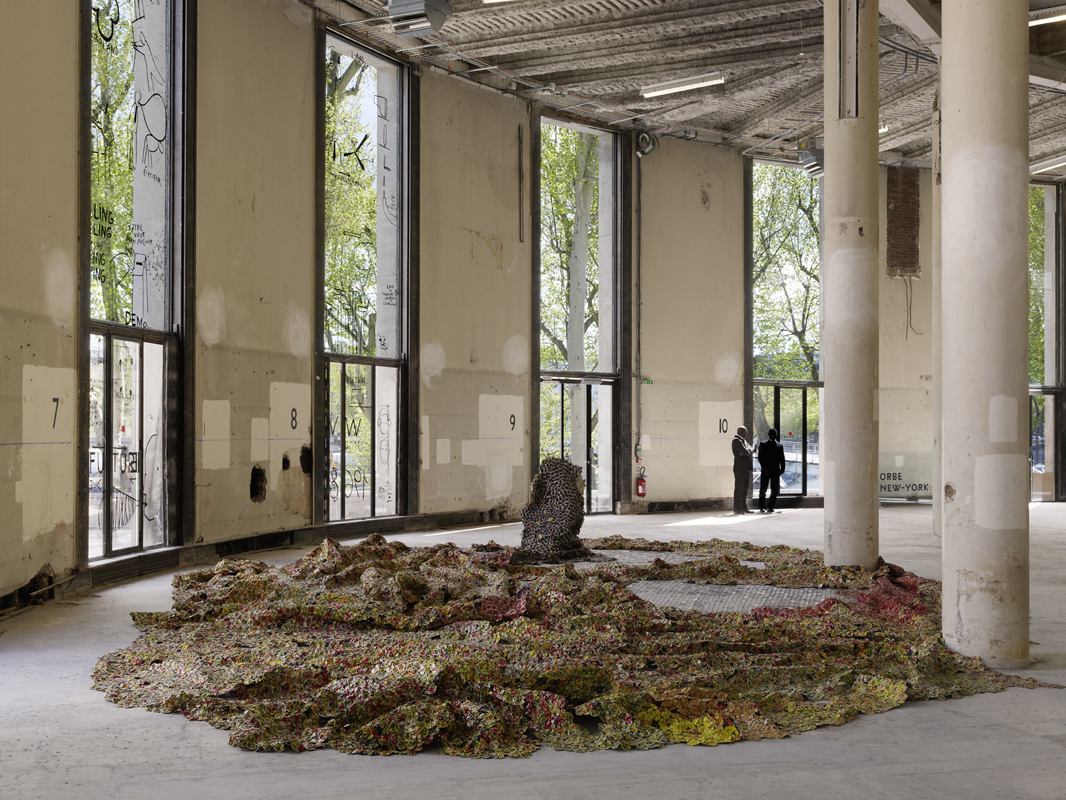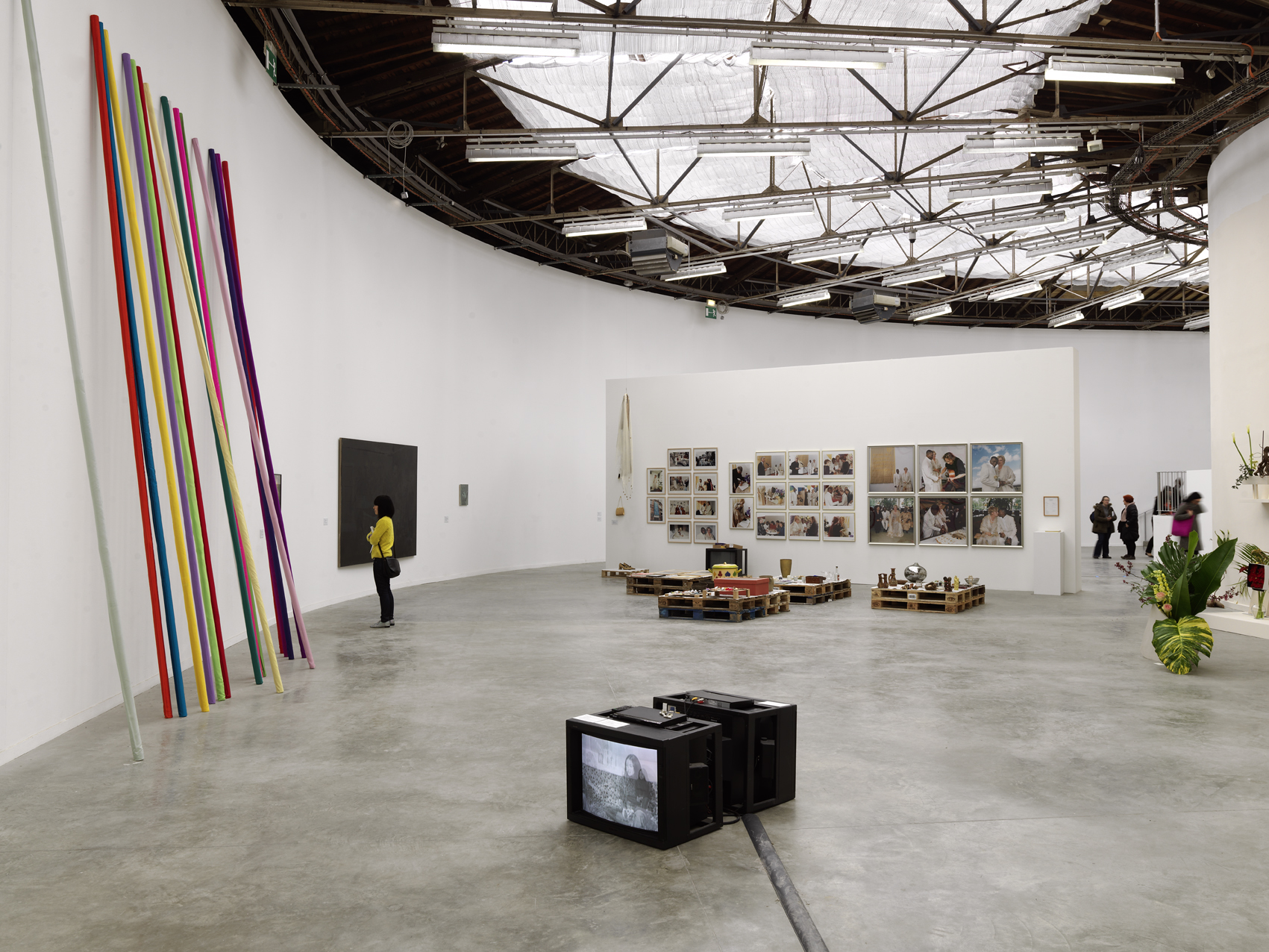
Vue de l’exposition « La Triennale, Intense Proximité », 20.04.12 - 26.08.12, Palais de Tokyo (Paris). Photo : André Morin. El Anatsui, « Tiled flower garden » , 2012, Courtesy de l’artiste et Jack Shainman Gallery, New York.
This is what I wrote in my notebook upon leaving La Triennale 2012: Intense Proximity, curated by Okwui Enwezor (Artistic Director) with Mélanie Bouteloup, Abdellah Karroum, Émile Renard and Claire Staebler, at the Palais de Tokyo in Paris:
This exhibition is the future, and at the same time it is the end of the world.
This impression was certainly sparked by the first artwork I saw on entering the newly removed Palais: Peter Buggenhout’s The Blind Leading the Blind. An enormous, heavy and dark sculpture made out of metal, rubber, canvas, wood and fabrics, coated with blood, resin and dust and hanging from the ceiling, the piece is described in the wall label as a “monumental disaster.” This hyperbolic description is, in fact, perfect: I felt like I was standing under an airborne shipwreck. I am not entirely sure that Buggenhout’s piece is actually meant to be part of the show, but it set a tone that resonated with the powerful and altogether disconcerting renovation of the Palais (by Anne Lacaton and Jean-Philippe Vassal). By the time I had “descended” into the lower levels of the exhibition, I was sure I had somehow crossed over, and was traversing the scenography for the movie Blade Runner.
I begin my Post-Card this way because I want to emphasize that the Triennale is not simply an art exhibition. It is, rather, an experience of art, lots of (often very good) art, in a context that feels like an archaeological expedition through space and time. A stage set filled with high drama, the show does not aim to set off discrete objects or highlight artists, trends or movements. Rather, as Enwezor wrote in his introduction, it aspires to be “a zone of encounter… in which contemporary realities become immanent, visible, present…(as) a field of contending discourses.” Moving down and through the complex labyrinths of the building, with its unfinished walls and its stripped surfaces that boldly display their historical layers, the viewer sails through time as well as space. The flashy and extravagant convergences of sculptures and paintings, installations and media, sound works and films glowing in the dark are experienced as kaleidoscopic in nature. Expanding outward into global space and moving both forward and backward in time, filled with works by artists living and dead, young and old, from many continents and traditions, the exhibition EMBODIES rather than explains the notion of “intense proximity.”
Okwui calls this the “politics of anti-difference:” the collapse of the distance between the Self and Other, the recognition that now we live with disjunction, in “the thickness of ethnocentric and identity based processes.” The exhibition begins with works by Marcel Griaule, Claude Lévi-Strauss, Jean Rouch and Pierre Verger: classic ethnographers who traveled through space to bring news of cultural difference to their neighbors back home. For Enwezor, ethnographic fieldwork and curatorship have much in common. But with the collapse of spatial and temporal distances taken for granted by earlier generations, the contemporary curator becomes an ethnographer by definition – and field work begins at home, with the study of the stranger who, through migration, slavery, colonialism and tourism, has now become a neighbor. The exhibition, essentially, stages this collapse.

Vue de l’exposition « La Triennale, Intense Proximité », 20.04.12 - 26.08.12, Palais de Tokyo (Paris). Photo : André Morin. Sarkis, « La chorégraphie des Trésors de Guerre » , 2011 ; La Frise Trésors de Guerre, 1976-2012, Courtesy de l’artiste et Galerie Nathalie Obadia, Paris, Bruxelles. © ADAGP Paris 2012.
Everything is in motion in the galleries of the Palais de Tokyo. This is an exhibition, and a world picture, with no center or still point, only continually shifting parameters and peripheries bound together by fences (“frontiers”) designed by Daniel Buren. Time, space and generations are seen as contexts as well as potentialities; and all of us are tourists in someone else’s reality when we cross boundaries defined by geography, race, class or culture. African American women like Lorraine O’Grady and Carrie Mae Weems relate their experiences, respectively, to Ancient Egypt and 19th century American slavery. Timothy Asch’s film from South America, showing an Ax Fight among Yanomami Indians, is juxtaposed with Helen Levitt’s record of children bashing each other in play on the streets of New York in the late 1940s. The German Lothar Baumgarten lived for a while in Brazil, Michael Buthe (also from Germany) learned from the North Africans and American Terry Atkins from the Inuit Eskimos of Alaska. Turkish born Koken Ergun’s video installation documents the subcultures and ceremonies of Pilipino workers in Tel Aviv, while Israeli writer Ariella Azoulay describes, through drawings and texts, the marginalization and effacement of Palestinian history in the national archives.
Thomas Struth and Guy Tillim take ironic looks at the exoticism of tropical paradises in their large color photographs, while Luc Delahaye finds a nature morte of war and death in Libya. Antoni Muntadas, Thomas Hirschorn and Alfredo Jaar interrogate the ways in which translation and media deflect and disable our ability to empathize and communicate while magnifying our terror of the unknown and each other. Fear Eats the Soul, in fact, is transcribed on one of the T-shirts pressed in the silkscreen printing workshop space of Rirkrit Tirivanija; and T-shirts, along with every other form of quotidian object, fill the ephemeral installation space of Georges Adéagbo. Born in Benin, Meschac Gaba married his blond Dutch girlfriend, and in his Marriage Room documents the experience in detail and shows us the cross-pollination of objects and people such a union makes possible. The young Polish artist Aneta Grzeszykowska’s terrific video – called Headache – was only one of a few fine feminist contributions from Eastern Europe; the older pioneer Ewa Partum also stood out in this context. Two of my favorite artists – El Anatsui and Nick Hlobo, born in Ghana and South Africa respectively – both have works in the show, as do Chris Ofili and Huma Bhabha, Annette Messager, Wangechi Mutu and Yto Barrada, Hassan Khan and Trinh T. Minh-ha.

Vue de l’exposition « La Triennale, Intense Proximité », 20.04.12 - 26.08.12, Palais de Tokyo (Paris). Photo : André Morin. Au premier plan : Adrian Piper, « The Mythic Being », 1973, Collection et copyright Adrian Piper Research Archive Foundation, Berlin. Au second plan, de gauche à droite : Seulgi Lee, "BÂTON", 2009, Courtesy de l’artiste et Jousse Entreprise ; Victor Man, « Deposition » , 2008, Collection Ginette Moulin - Guillaume Houzé, Paris ; Meschac Gaba, « Marriage Room » , 2000, Courtesy de l’artiste et Stevenson, Cape Town, Johannesburg, ADAGP Paris 2012 ; Camille Henrot, « Est-il possible d’être révolutionnaire et d’aimer les fleurs ? » , 2012, Courtesy de l’artiste et Kamel Mennour, Paris.
The list might seem endless, but this is just the beginning. There are, in fact, 109 projects in the 5,000 square meters of exhibition space available in the renovated Palais de Tokyo. All told, I think I spent roughly seven hours in the building, and the Triennale continues in other Parisian venues like Bétonsalon – Centre d’art et de recherche and Centre d’art contemporain d’Ivry-le Crédac. Overwhelming? Chaotic? A bit, yes, but ultimately that is in fact the point. There are no neat edges or tidy isms in this show. There are only endless artists and images rubbing shoulders and trying to coexist in a space – real and conceptual — whose delineations are not, and may never be, clear. All in all, the 2012 Triennale is both a cornucopia of plenty and a deeply unnerving vision of dissonance, and I remain committed to my first impression: for me it represents, simultaneously, the future and the end of the world. As I see it, Enwezor’s ability to envision and shape such a complex and irresolvable experience is, indeed, a major achievement.
Shelley Rice
©Shelley Rice, 2012.